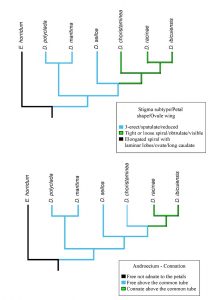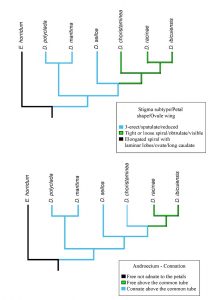Errata
Errata 1)
Maruyama PK, Nunes CEP, Vizentin-Bugoni J, Gustafsson S, Morellato LPC. 2018. Are native bees and Apis mellifera equally efficient pollinators of the rupestrian grassland daisy Aspilia jolyana (Asteraceae)? Acta Botanica Brasilica 32 (ahead).
Abstract
Consider:
Most angiosperms rely on animals for pollination, and insects, especially bees, are the most frequent pollinators.
Instead:
Most angiosperms rely on animals for pollination, and insects, especially bees, are being the most frequent pollinators.
Errata 2)
Carvalho JDT, Essi L, Oliveira JMS. 2017. Flower and floral trichome morphology of species of Dyckia Schult. f. (Bromeliaceae, Pitcairnioideae), and their importance to species characterization and genus taxonomy. Acta Botanica Brasilica 31: 29-41.
Figure 5. Some of the main phylogenetically informative morphological characters mapped in one of the three most parsimonious trees inferred.
Consider: Instead:


Errata 3)
Silva NA, Alves AGC, Albuquerque UP, Ramos MA. 2019. A biocultural approach to the use of natural resources in Northeast Brazil: A socioeconomic perspective. Acta Botanica Brasilica 33(2): 315-330.
Abstract
Consider:
The influence of socioeconomic factors on the knowledge and use of natural resources related to intangible aspects of culture differs, in some respects (schooling, income and occupation), from that reported for the use of natural resources for subsistence purposes.
Instead:
The influence of socioeconomic factors on the knowledge and use of natural resources related to intangible aspects of culture differs, in some respects (schooling, gender and occupation), from that reported for the use of natural resources for subsistence purposes.
Table 4.
Consider:
Equidae
Equus asinus (Linnaeus, 1758)
Equus caballus (Linnaeus, 1758)
Instead:
Caviidae
Equus caballus (Linnaeus, 1758)
Equidae
Equus asinus Linnaeus, 1758
Table 4.
Consider:
Phasianidae
Instead:
Tinamidae
Errata 4)
Sousa DGD, Cunha HFD. 2020. Structural assessment of a population of Anacardium humile subjected to fire during different periods of the year. Acta Botanica Brasilica 34: 401-408. https://doi.org/10.1590/0102-33062019abb0408
Materials and methods
Experimental design and inventory
Consider:
The flames in the EF area were, on average, 0.93 m height, with average fire spread of 0.019 m/s, and in the LF area, the flames were, on average, 2.86 m height, with average fire spread of 0.11 m/s.
Instead:
The flames in the EF area were, on average, 0.33 m height, with average fire spread of 0.019 m/s, and in the LF area, the flames were, on average, 2.86 m height, with average fire spread of 0.11 m/s.
Discussion
Consider:
The late fire had higher flame height (mean of 2.86 m) and spread rate (0.11 m/s) than the early fire (mean flame height: 0.93 m; spread rate: 0.019 m/s). Considering the average height of individuals in the control area (92.17 cm), which represent the size of those within the burned areas at the time of fire spread, the flames in the LF area exceeded the size of the plants over 2 m, thus, with a great damage potential to A. humile individuals. Individuals in this area were more vulnerable to mass topkill, different from the EF area, where the flames had an average height of 0.93 m, similar to the average height of their individuals.
Instead:
The late fire had higher flame height (mean of 2.86 m) and spread rate (0.11 m/s) than the early fire (mean flame height: 0.33 m; spread rate: 0.019 m/s). Considering the average height of individuals in the control area (92.17 cm), which represent the size of those within the burned areas at the time of fire spread, the flames in the LF area exceeded the size of the plants over 2 m, thus, with a great damage potential to A. humile individuals. Individuals in this area were more vulnerable to mass topkill, different from the EF area, where the flames had an average height of 0.33 m, lower than the average height of their individuals.
When authors publish in Acta Botanica Brasilica they receive additional benefits:
Copyright © 2016 ACTA BOTANICA BRASILICA®




